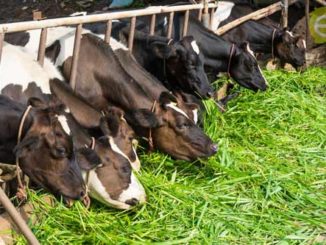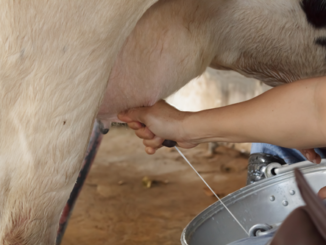For a calf, the care begins from the care of its mother during calving. Calving pen needs to be clean and comfortable to prevent calving problems. Diseases transmission risk reduces from the mother to calf if it is separated early from her. Always keep the surroundings disinfected to prevent potential disease spread.
Successful calving is the first step towards successful calf rearing. Death of many calves occur during calving and many others suffer from oxygen deficiency or from bruises which adversely affects their survival rate. The boxes or place where calves are kept either as single or multiples must have enough space for the, should be clean and disinfected along with proper soft bedding which can absorb their excreta.
Floor should have enough grip to prevent the animal and calf from slipping during calving. Farm needs to be well ventilated to avoid problems of humidity and wet bedding. Farm should be build in such a way so as to enable easy supervision so that the cow and calf can be carefully examined without causing them any disturbance immediately after calving. Cleaning and disinfection should be carried out between each calving or group, allowing the pen to dry properly afterwards. Remove mucus from nostrils and mouth of new borne calves to enable them to breathe and suckle. If the calf does not respond to such treatments then hold it from the hind legs and give a short jerk. Immediately after birth, make sure to dry the calves with a clean towel to prevent the loss of body heat. Dry bedding for calves also ensures against cold weather. Also disinfect the navel by dipping in povidone iodine solution.
In addition weigh the calf and record at regular intervals. Colostrum should be fed within few hours of birth at least 10 percent of the body weight. Keep a record of the calf body weight and also monitor its temperature every few hours. Keep the calves separately in individual pens atleast for first two weaks so that their problems can be identified early and corrections applied therein. This also facilitates the buildup of strong immunesystem and prevention of diarrhea and related respiratory diseases. Excess of colostrums should be stored hygienically in cold environment. A calf should be checked for its IgG status after 2-7 days of colostrums feeding and in case colostrums is insufficient or not available, supplemts and replacers need to be used. Calves with low levels of immunoglobulin absorption will experience the incidences of more diseases along with an increase in neonatal mortality due to diarrhoea, respiratory disease and an increase in veterinary costs and use of antibiotics. The calf pens should protect against heat and cold stress appropriately for comfort. Start feeding and handling the youngest calves and end with the oldest to avoid spread of infections.
Check calf health at least twice daily and record, inform and act immediately on issues. House sick or weak calves separately until they have recovered and are vigorous. If the claves fail to suckle teach them by dipping your two fingers in milk and taking to its mouth or they can be fed from utensils or milk bottle after appropriate temperature level according to environment. Gentle handling of hungry calves helps speed up independent feeding. Providing a source of heat during cold weather has been shown to increase the intake of calves in the first 2 days after birth. Housing calves individually during their first days of life will also make it easier to monitor which calves are performing well, and which are not. A variety of facilities can be used to raise dairy calves. However, no matter what system is used it has to meet a number of basic requirements in order to consistently produce healthy and well grown calves on a year-round basis. The minimum space requirement during the calf’s first weeks of life is 80 x120 cm or 2.6 x 3.9 feet (1 m2 or 10 ft2) but can this vary depending on local regulations. Light should be in plenty to make it easier for the calves to move around and efficiently use the food provided to it. During the first month of life diarrhoea is the main cause of death. The economic impact of diarrhea is significant because of losses due to calf death and reduced growth and longer rearing periods for the survivors.
The impact is long-lasting since these calves have been shown to have later calving dates and be in poorer condition at calving. Other costs include extra labour and veterinary expenses. Highest death rate among calves occur during the first 2 weeks of life. Offer free choice of good quality calf starter. Discard unconsumed calf starter between feedings. Provide free choice of fresh water. Give enough room for moving around, playing and running. When dehorning calves, use a local anaesthetic or pain killer. As the calf grows and begins to consume solid feed, its stomach compartments grow and mature accordingly. At birth, the abomasum makes up 60% of stomach capacity, the reticulum and rumen about 30%, and the omasum approximately 10%. By four weeks of age, however, their relative sizes have reversed. The abomasums continues to function as it did at birth and grows in proportion to the calf’s body size. However, the reticulum and rumen greatly increase in size and in function to become the most important part of the stomach system. The newborn calf is a poor digester of carbohydrates (with the exception of lactose or milk sugar). When the calf begins to eat solid feed, particularly grains containing readily fermentable starch, the rumen supplies nutrients to the bacteria which in their turn start to grow and populate the rumen. The starch produces volatile fatty acids (VFA), which stimulate growth of rumen papillae and metabolic activity in the rumen. It takes about 3 weeks to develop the rumen papillae from the start of feeding starch. Hence, providing free-choice grain starting at an early stage and assisting the calf in eating those first bites can have positive effects on rumen development. If the calf is fed only milk or milk replacer, development and differentiation of the rumen will be negatively affected. A calf fed grain in addition to milk shows better rumen development.






1 Trackback / Pingback